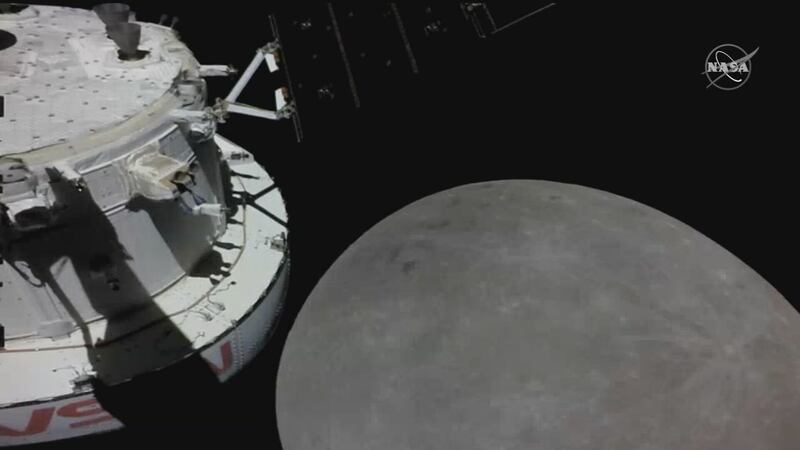NASA’s Orion space capsule has reached the Moon, and NASA posted images Monday morning showing the capsule arriving in the neighborhood.
The Orion capsule buzzed the moon’s surface and got really close. NASA said it whipped around the back of the Moon and passed within 80 miles.
The approach came on the far side of the Moon. Due to the flight path there was a communication lag of about a half-hour. Flight controllers in Houston were in the dark about some key functions of the Orion capsule until it emerged from behind the Moon. Because of the communication blackout, the controllers did not know if the critical engine firing went well until the capsule emerged from behind the Moon.
It’s the first time a capsule has visited the Moon since the Apollo program 50 years ago.
Orion blasted off last Wednesday from Florida’s Kennedy Space Center on a three-week flight.
The launch of the capsule happened after 1 a.m. on Wednesday, Nov. 16 on the Artemis 1 rocket. The space capsule traveled 232,000 miles in a little less than a week.
Kristi Morgansen is chair of Aeronautics and Astronautics at the University of Washington. She spoke to KIRO 7 and said she had attended the first few launch attempts when the rocket launch was scrubbed. She was not able to attend the night launch on Nov 16.
Morgansen stressed that even though NASA is making its second series of visits to the Moon on the latest Artemis missions, the Moon is fresh territory for groundbreaking research that could get us to Mars.
“Until you verify that everywhere along the way — that everything’s going properly, we don’t want to send humans off to Mars until we’re really sure it’s going to be OK. There’s still a lot we don’t know and that’s part of what we’ll do on the Moon,” said Morgansen.
Morgansen stresses that the Moon is one of the harshest environments and says if we can build and maintain a presence there — which is NASA’s goal — we could theoretically build almost anywhere in the solar system.
“We know that there’s water,” said Morgansen.
She also stresses that other research that could happen on the Moon could allow scientists to make advances in other fields of science and development.
“There may be medications that we develop that can be much more efficiently manufactured in low gravity than here on the planet. There’s a lot we can learn about how do we build sustainable communities, sustainable energy, sustainable food,” said Morgansen.
The approach to the Moon is a milestone for the $4.1 billion test flight that began last week. Orion’s flight path also took it over the landing sites of Apollo 11, 12 and 14. Those were humanity’s first three lunar touchdowns.
The hope for mission managers is to establish orbit around the Moon by Friday of this week.
Redmond-based Aerojet Rocketdyne helped design propulsion for the Orion capsule that will help it get into position around the Moon and for its return to Earth on Dec. 11.
©2022 Cox Media Group







